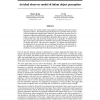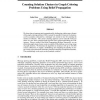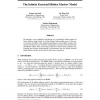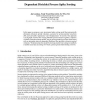NIPS
2008
14 years 29 days ago
2008
Before the age of 4 months, infants make inductive inferences about the motions of physical objects. Developmental psychologists have provided verbal accounts of the knowledge tha...
NIPS
2008
14 years 29 days ago
2008
We show that an important and computationally challenging solution space feature of the graph coloring problem (COL), namely the number of clusters of solutions, can be accurately...
NIPS
2008
14 years 29 days ago
2008
We introduce a novel framework for estimating vector fields using sparse basis field expansions (S-FLEX). The notion of basis fields, which are an extension of scalar basis functi...
NIPS
2008
14 years 29 days ago
2008
In this paper we aim to train deep neural networks for rapid visual recognition. The task is highly challenging, largely due to the lack of a meaningful regularizer on the functio...
NIPS
2008
14 years 29 days ago
2008
We introduce a new probability distribution over a potentially infinite number of binary Markov chains which we call the Markov Indian buffet process. This process extends the IBP...
NIPS
2008
14 years 29 days ago
2008
Almost all successful machine learning algorithms and cognitive models require powerful representations capturing the features that are relevant to a particular problem. We draw o...
NIPS
2008
14 years 29 days ago
2008
In this paper we propose a new incremental spike sorting model that automatically eliminates refractory period violations, accounts for action potential waveform drift, and can ha...
NIPS
2008
14 years 29 days ago
2008
Many popular optimization algorithms, like the Levenberg-Marquardt algorithm (LMA), use heuristic-based "controllers" that modulate the behavior of the optimizer during ...
NIPS
2008
14 years 29 days ago
2008
We consider multi-armed bandit problems where the number of arms is larger than the possible number of experiments. We make a stochastic assumption on the mean-reward of a new sel...
NIPS
2008
14 years 29 days ago
2008
This paper presents the first Rademacher complexity-based error bounds for noni.i.d. settings, a generalization of similar existing bounds derived for the i.i.d. case. Our bounds ...




